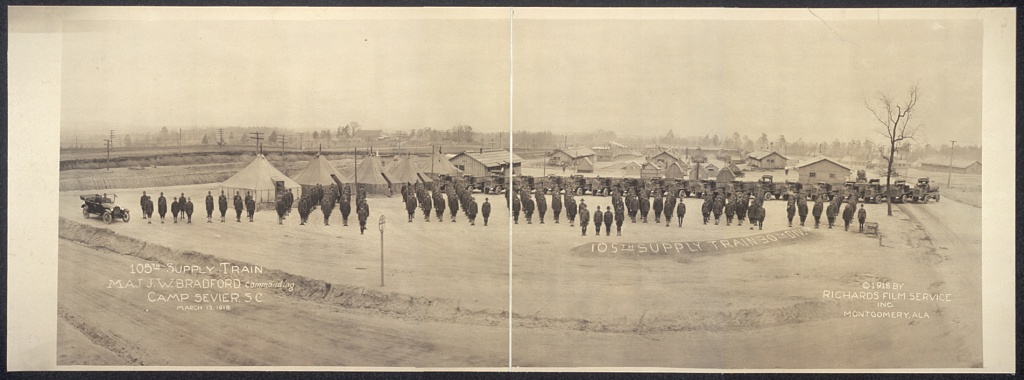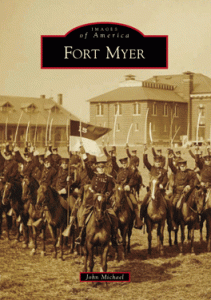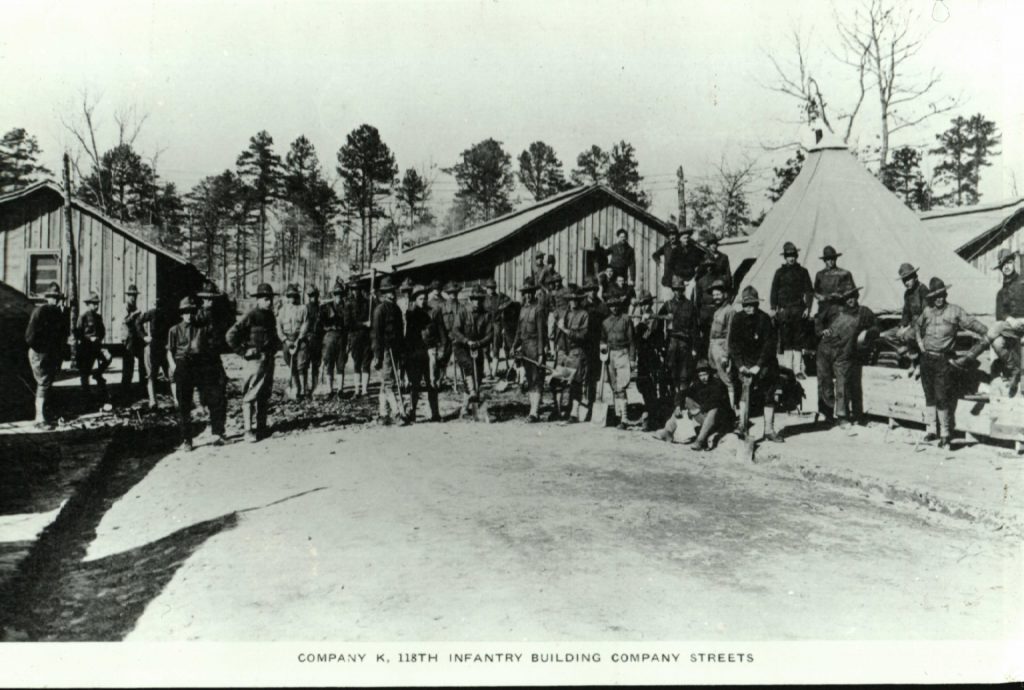Camp Sevier was a temporary cantonment site in Greenville County created to train federalized National Guard soldiers during World War I.
Camp Sevier was a temporary cantonment site in Greenville County created to train federalized National Guard soldiers during World War I. It was named in honor of the Revolutionary War hero John Sevier, a leader of patriot militia at Kings Mountain and later governor of Tennessee. Soldiers from South Carolina began to occupy the site, four miles northeast of the city of Greenville, on July 10, 1917. Construction began a week later, and the formal establishment of the post took place on July 18. During the next two months, various National Guard units from South Carolina, North Carolina, and Tennessee began to arrive at the camp. Before training could begin in earnest, the land had to be cleared and facilities constructed. Once all units had reported, soldiers were trained in a range of common infantry skills and in new modes of warfare, such as gas defense and the use of the machine gun. Covering some nineteen hundred acres, the camp provided ample room for artillery instruction as well. This first group of guardsmen was formed into the Thirtieth, or “Old Hickory,” Division, which trained at the post until May 1918 and was followed by the Eighty-first and Twentieth Divisions, respectively. In all, an estimated 100,000 men had undergone vital training at Camp Sevier by the spring of 1919. With the signing of the Armistice on November 11, 1918, the post was designated as a demobilization center on December 3 and was closed as a military training facility on April 8, 1919.
Doyle, Alex C. Completion Report of Camp Sevier, Greenville, S.C. Greenville, S.C., 1919.
Huff, Archie Vernon, Jr. Greenville: The History of the City and County in the South Carolina Piedmont. Columbia: University of South Carolina Press, 1995.
Withington, Frances Marshall. “Camp Sevier, 1917–1918.” Proceedings and Papers of the Greenville County Historical Society 4 (1971): 76–85.
The Guns of August Paperback – March 8, 1994
by Barbara W. Tuchman (Author)
ABOUT THE BOOK:
Selected by the Modern Library as one of the 100 best nonfiction books of all time
The Proud Tower, the Pulitzer Prize–winning The Guns of August, and The Zimmerman Telegram comprise Barbara W. Tuchman’s classic histories of the First World War era
In this landmark, Pulitzer Prize–winning account, renowned historian Barbara W. Tuchman re-creates the first month of World War I: thirty days in the summer of 1914 that determined the course of the conflict, the century, and ultimately our present world. Beginning with the funeral of Edward VII, Tuchman traces each step that led to the inevitable clash. And inevitable it was, with all sides plotting their war for a generation. Dizzyingly comprehensive and spectacularly portrayed with her famous talent for evoking the characters of the war’s key players, Tuchman’s magnum opus is a classic for the ages.
Praise for The Guns of August
“A brilliant piece of military history which proves up to the hilt the force of Winston Churchill’s statement that the first month of World War I was ‘a drama never surpassed.’”—Newsweek
“More dramatic than fiction . . . a magnificent narrative—beautifully organized, elegantly phrased, skillfully paced and sustained.”—Chicago Tribune
“A fine demonstration that with sufficient art rather specialized history can be raised to the level of literature.”—The New York Times
“[The Guns of August] has a vitality that transcends its narrative virtues, which are considerable, and its feel for characterizations, which is excellent.”—The Wall Street Journal
AND There Were More…
John Michael‘s book Images of America – Fort Myer highlighted the Remount Service of the United States Army and the companion website for the book drilled down even further to provide insight into the major remount depots – there were just four and referred to the fact there were 39 substations across the United States When the US Army Moved by Horse

310 Auxiliary Remount Depot, Major Hayden W. Wagner, commanding, Camp Sevier, S.C., March 16th, 1918
Camp Sevier contained one of the 39 substations that in addition helped prepare the United States for World War I with other units that were organized and trained within the camp. What follows are some of those units. for a more detailed view of the organization’s combat service during World War I, Combat_Service_of_Organizations_of_the_US_Army_in_the_WW I (WARNING LARGE FILE ! OVER 8 MB) issued by the US Army War College in 1931 here.

105th Supply Train, Maj. J.W. Bradford commanding, Camp Sevier, S.C., March 13, 1918
A variety of units were constituted, organized, and trained for deployment to the European theater

119th Infantry, Col. F. LeJ. Parker, commanding, Capt. John H. Manning, adjutant, Camp Sevier, S.C., March 8th, 1918
So it went beyond providing a remount service substation

120th Infantry, Col. William B. Cochran, commanding, Camp Sevier, S.C., March 16th, 1918
It is hoped that the display of these images shows the amount of effort and preparation that went into the United State Army’s contribution to winning World War I

West from “Y” 82, at Paris, Camp Sevier, S.C.
100 years later, the Great War’s impact on Greenville remains evident
Courtesy of the Greenville Journal
January 18, 2018
This year marks the 100th anniversary of the end of World War I, a conflict that dragged nations from all across the globe into four years of unprecedented bloodshed.
Between the start of the war on July 28, 1914, and the end of the war on Nov. 11, 1918, more than 18 million people were killed and 21 million wounded. The American diplomat, George Kennan, described the war as “the seminal catastrophe of this century.”
However, the war did much more than cause a global massacre. It allowed millions of women to enter the workforce, featured the initial step of the United States as a world power, and helped to transform Greenville into the city it is today.
Building a camp
When the United States declared war on Germany in April 1917, Secretary of War Newton Baker ordered the construction of 32 training camps, according to local historian and documentary filmmaker Don Koonce. “Most of these cantonments or training camps were to be spread across the Southeast where moderate weather would provide more training days and shorter preparation time before sending the men overseas,” he said.Local business leaders sensed an economic opportunity and began lobbying for a camp soon after. They were successful. In July 1917, the U.S. Army appointed Greenville’s J.E. Sirrine & Co. and Gallivan Construction to build a 1,900-acre training camp near the base of Paris Mountain for the newly created 30th Infantry Division, which was composed of National Guard soldiers from South Carolina, North Carolina, and Tennessee.
The division was nicknamed the “Old Hickory” division in honor of U.S. president Andrew “Old Hickory” Jackson, who was born near the borders of the three states.
Soldiers from the 1st South Carolina Infantry arrived in Greenville soon after and began to construct the camp, according to Koonce. About 20,000 additional soldiers arrived in the following weeks, and by Aug. 31 the camp was considered complete. It was named Camp Sevier in honor of John Sevier, a Revolutionary War hero, and Tennessee’s first governor.
The camp included divisional headquarters, drill grounds, YMCA facilities, stables, a chapel, a bakery, a post office, a library, more than a dozen warehouses, and at least four medical buildings. It was also equipped with electricity, running water, and telephone and telegraph lines. The camp, however, did not have barracks, according to Koonce. Soldiers instead lived in pyramidal tents, formed in rows along the camp’s dusty roads.
Read the rest of the article with more photographs at the Greenville Journal
BUY THE BOOK
Images of America – Fort Myer is a pictorial chronicle of the first one hundred years of history containing over two hundred photographs, maps, and images. Beginning in the 1860s and carrying through the 1960s it provides a view of what was over time. An autographed copy of the book can be purchased at BUY THE BOOK.









